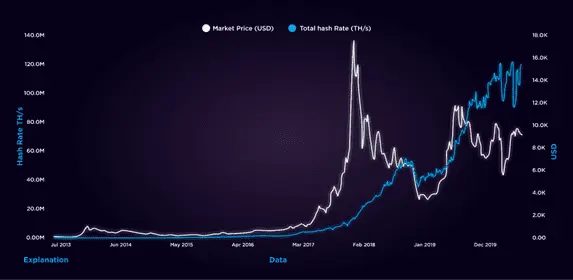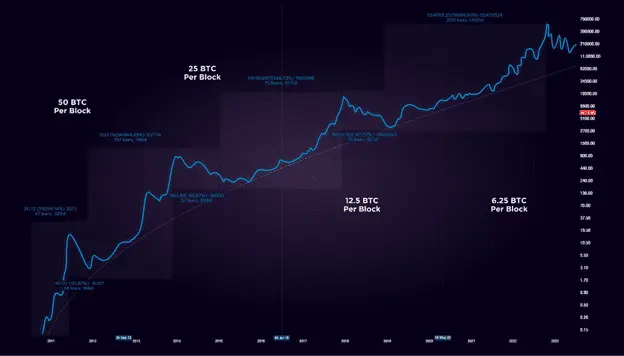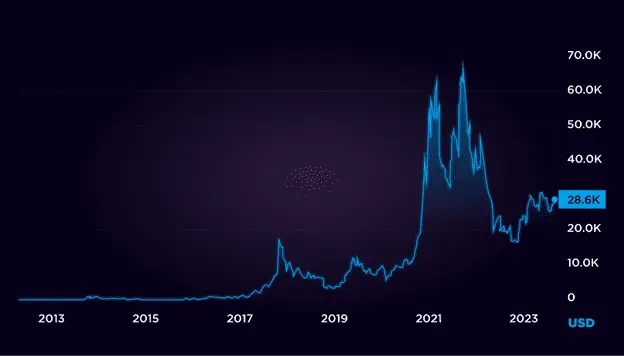Bitcoin was launched in 2009. When miners started servicing the network after it first launched, they were compensated with Bitcoin (BTC) in the form of rewards. For each block mined, 50 BTC was distributed to the handful of miners servicing the network based on the rewards algorithm and how much each miner contributed to processing power. The first transaction recorded was in October 2009 and logged a price of $0.0009 cents on the dollar. Today, Bitcoin has a price of roughly $28,000 USD and there are roughly 1 million miners participating throughout the world.
Why is halving significant?
The bitcoin algorithm produces 1 block every ~10 minutes. On average, each block will record 500 – 2,000 transactions. Within the blockchain infrastructure, Nodes broadcast and relay transactions on the network to Miners, who build the blocks on the network that verify, approve, and store every transaction. Normally, each transaction requires 6 confirmations on the network for a transfer to be approved and recorded on the blockchain, forever. Nodes and Miners are compensated for their work in BTC for their services.
In Proof-of-Work (PoW) blockchains like Bitcoin, the rewards are higher in the infancy of the blockchain to incentivize Miners to service the network which gives it greater strength in decentralization. In 2009, rewards for mining bitcoin were 50 BTC per block, therefore, every day 6,000 BTC was distributed in rewards. As the blockchain gains popularity and price increases, those rewards are cut in half after each halving period. Most PoW blockchains have halving periods every ~4 years.
Bitcoin has gone through three halving cycles: 2012, 2016, 2020. The next halving cycle begins early April 2024. Bitcoin has a fixed total supply of 21.000.000 BTC that are available to be mined. Therefore, once the rewards end, Bitcoin will be fully diluted, and there is no producing more.
With fiat currencies, users have no control over our country’s monetary policy and how much our central bank prints money, or how they decide to adjust interest rates. With Bitcoin, no one centralized group controls the network, therefore the supply is finite and there is complete clarity over its functioning and economics. This is one of the principal reasons why Bitcoin was created and why it has gained so much popularity.
Here is Bitcoin’s monetary policy for the next 100 years.

The Bitcoin Hash Rate is Going Parabolic
The hash rate on the Bitcoin network is the total processing power of Miners servicing the network. The hash rate is also an indicator for interest and business backing Bitcoin mining services. In the first halving period, there were only a few thousand miners who were reaping the rewards. Now, as the hash rate is growing year over year, current statistics estimate over a million mining machines processing the network with more efficient processing speeds. Now, more than ever, are individuals and business groups deciding it’s a worthwhile investment.
The Hash Rate is diverging positively away from BTC’s nominal price in USD.

Apart from processing power, the hash rate is also an indicator to BTC’s price in nominal terms. There is moderate-to-strong correlation between the two. Through bull or bear markets, the two generally move in tangent. If markets are strong and BTC’s price is high in USD, it attracts more miners to the network. The same is true about the opposite scenario. In recent months, we’ve seen the hash rate explode in growth, trending positively above the USD price. Miners are edging out every BTC of this halving period as buy side interest seems to be growing.
Sell Side Pressure from Miners will Continue to Drop
Bitcoin miners endure costs, mainly in the form of electricity consumption, hardware, maintenance, and rent. This means they have a business to run, and their main source of revenue is BTC. Therefore, more times than not, they are constantly selling BTC or using BTC to pay for goods and services. This equates to consistent sell side pressure in the market.
In the current halving period, there are 6.25 BTC rewards per block which is roughly 900 BTC rewarded per day, which equates to ~$24 million USD in sell side pressure per day with today’s market rate. As we approach the 5th halving period, that number will reduce by 50% and drop to 450 BTC per day. As we enter each new halving period, there is less sell side pressure.
Daily BTC trading is in the billions, and Coinmarketcap reported the monthly average at $14.1 billion USD in daily trading volume for August 2023. While 450 BTC is only a drop in the bucket on daily trading volume, the halving period signals to the market that non-circulating supply is running out.
Trends of the Past Signal the Future
Bitcoin enthusiasts are excited for April, and they have a good reason to remain excited. After each halving period, we’ve seen strong growth in price, volume, and user base.
‘Bubbles’ don’t last 14 years so don’t expect a ‘burst’.

As with most things, the value in Bitcoin comes down to three main things: Supply & demand, utility, and perception.
Bitcoin is rare. Like really rare. Rarer than gold. But at the same time is easier to acquire than gold – you don’t need to leave your house to get it, and you can own the real thing, not like an ETF. Roughly 500.000 BTC are traded per day among traditional buyers and sellers, speculative traders, and institutions. 10 years ago, only 50k active bitcoin addresses were populated on the network. Today, around 1 million active addresses are registered, each one storing more BTC than before. Along with Miners, more buyers are entering the game.
Utility lies in the eye of the beholder. As gold was sought after in its early years of adoption, mainly for trade, Bitcoin is experiencing a similar adoption curve and has simultaneously staked claim to its own asset class: digital assets. Whether its borderless payment settlement or inflation protection, Bitcoin is experiencing cross-sector adoption. If you were to buy BTC in 2014 and hold, it would return a ~228x on the investment. To date, it’s been the best performing asset in the past 10 years and many portfolio managers are adding it to improve volatility, diversification, and risk adjusted return.
Bitcoin has been the best performing asset in the past 15 years.

Perception is arguable and pricing is imperfect; the two vastly contribute to volatility in today’s financial markets. When new information is disclosed and investor make themselves aware, it can make significant impact on publicly trades assets. The same applies to Bitcoin and the halving cycle is already embedded in that perception. When other news drops, like Blackrock’s initial approval for a BTC spot ETF, the speculative traders and enthusiasts go wild.
Institutional Money is on the Horizon
Speaking of Blockrock’s ETF, there is a long cue at the SEC in the United States of the country’s largest institutional asset managers rushing to launch BTC spot ETFs. News broke last week that the SEC is forfeiting its battle against stopping Greyscale in their efforts to convert their OTC ETF fund to a spot EFT for BTC after a federal judge ruled in favor of Greyscale. This sets precedent and essentially paves the way for others to launch their spot ETFs in the United States. For reference, Greyscale currently holds ~800,000 BTC in their wallets for clients.
Blackrock, Fidelity, and Invesco, to name a few, collectively manage $14+ trillion USD (yes, with a T), and all have submitted applications to launch spot ETFs for BTC. This means that institutional grade products, regulated by the SEC, will be offered to institutional investors in the US. For every dollar that goes in at net asset value (NAV) for the day’s trade, an equal amount of BTC will need to be stored in their wallets as backing.
It’s big for many reasons, but principally because these products will open the avenue to billions in available capital who were otherwise prohibited to invest in Bitcoin due to their investment mandate guidelines. Initial estimates are anticipating ~$200B USD in inflows in the first 12 months. Price estimates from Wall Street are expecting a 4x increase in the all-time-high (ATH), pegging Bitcoin at ~240k USD in the next 18 months.
It’s taken 15 years for the top portfolio managers in the US to enter the game. The Miners, however, have always been bullish.
Read the full article written by Alex Cavallero, COO of Kii Global, on the Forbes website.








